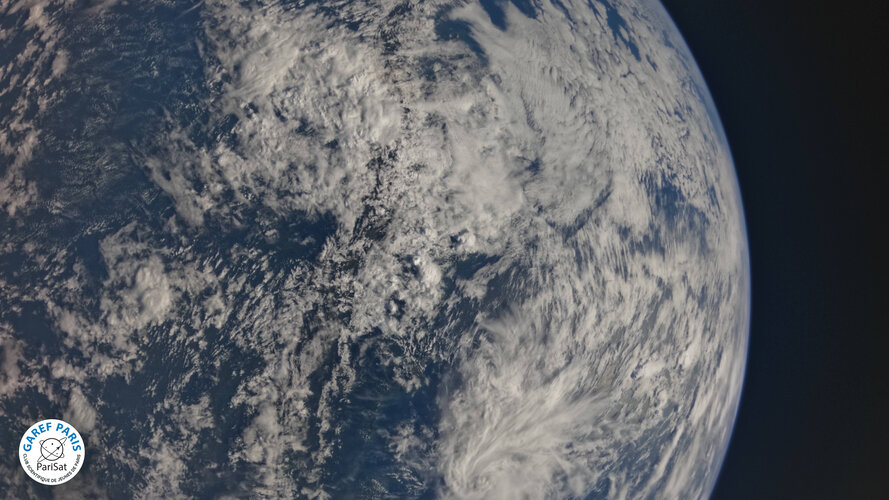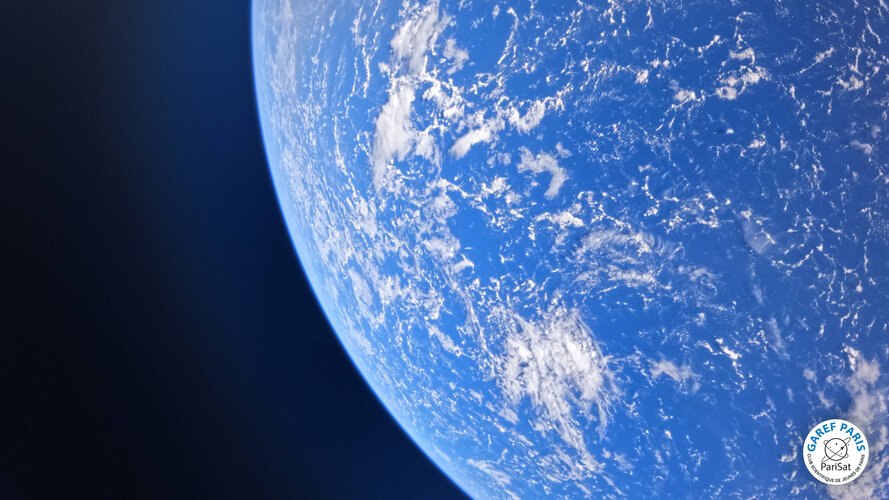
Copernical Team
Saturday, 20 July 2024 06:00
ESA stations support three Moon missions in 2024

Happy International Moon Day!
ESA’s network of satellite communication stations – Estrack – continues to connect Earth and the Moon in 2024. ESA stations are supporting three new and returning partners this year: one of them carried ESA’s first scientific instrument to the lunar surface and another will deploy the first Moon rover made in Europe.
Published in
News
Tagged under
Friday, 19 July 2024 07:44
PariSat school experiment sends back stunning Earth pics
 Image:
PariSat school experiment sends back stunning Earth pics
Image:
PariSat school experiment sends back stunning Earth pics
Published in
News
Tagged under
Friday, 19 July 2024 07:46
Black body experiment on Ariane 6 captures Pale Blue Dot
 Image:
Black body experiment on Ariane 6 captures Pale Blue Dot
Image:
Black body experiment on Ariane 6 captures Pale Blue Dot
Published in
News
Tagged under
Friday, 19 July 2024 18:48
New Hertz 2.0 building enhances space antenna testing at ESTEC
Paris, France (SPX) Jul 19, 2024
 The latest addition to ESA's ESTEC technical center in the Netherlands, the Hertz 2.0 building, stands more than 22 meters high beside its neighboring sand dunes, but here is the view inside.
Seen here being lined with steel plates that will serve to insulate it from external radio signals, this spacious test area will be employed to evaluate the performance of a new generation of bigger a
The latest addition to ESA's ESTEC technical center in the Netherlands, the Hertz 2.0 building, stands more than 22 meters high beside its neighboring sand dunes, but here is the view inside.
Seen here being lined with steel plates that will serve to insulate it from external radio signals, this spacious test area will be employed to evaluate the performance of a new generation of bigger a
 The latest addition to ESA's ESTEC technical center in the Netherlands, the Hertz 2.0 building, stands more than 22 meters high beside its neighboring sand dunes, but here is the view inside.
Seen here being lined with steel plates that will serve to insulate it from external radio signals, this spacious test area will be employed to evaluate the performance of a new generation of bigger a
The latest addition to ESA's ESTEC technical center in the Netherlands, the Hertz 2.0 building, stands more than 22 meters high beside its neighboring sand dunes, but here is the view inside.
Seen here being lined with steel plates that will serve to insulate it from external radio signals, this spacious test area will be employed to evaluate the performance of a new generation of bigger a
Published in
News
Tagged under
Friday, 19 July 2024 18:48
China plans to launch pilot cities to showcase BeiDou applications
Sydney, Australia (SPX) Jul 19, 2024
 China is gearing up to promote the extensive use of the BeiDou Navigation Satellite System by designating several pilot cities to highlight BeiDou's applications in mass consumption, manufacturing, and emerging sectors such as the Industrial Internet and Artificial Intelligence (AI), according to an announcement by the Ministry of Industry and Information Technology (MIIT).
"The large-scal
China is gearing up to promote the extensive use of the BeiDou Navigation Satellite System by designating several pilot cities to highlight BeiDou's applications in mass consumption, manufacturing, and emerging sectors such as the Industrial Internet and Artificial Intelligence (AI), according to an announcement by the Ministry of Industry and Information Technology (MIIT).
"The large-scal
 China is gearing up to promote the extensive use of the BeiDou Navigation Satellite System by designating several pilot cities to highlight BeiDou's applications in mass consumption, manufacturing, and emerging sectors such as the Industrial Internet and Artificial Intelligence (AI), according to an announcement by the Ministry of Industry and Information Technology (MIIT).
"The large-scal
China is gearing up to promote the extensive use of the BeiDou Navigation Satellite System by designating several pilot cities to highlight BeiDou's applications in mass consumption, manufacturing, and emerging sectors such as the Industrial Internet and Artificial Intelligence (AI), according to an announcement by the Ministry of Industry and Information Technology (MIIT).
"The large-scal
Published in
News
Tagged under
Friday, 19 July 2024 18:48
Maxar reveals initial images from WorldView Legion satellites
Los Angeles CA (SPX) Jul 19, 2024
 Maxar Intelligence, a leader in secure and precise geospatial intelligence, has released the first images captured by its next-generation WorldView Legion satellites. The first two of these satellites were launched from Vandenberg Space Force Base, California, on May 2, 2024.
The 30 cm-class high-resolution images were gathered on July 16, 2024, showcasing the advanced capabilities of the
Maxar Intelligence, a leader in secure and precise geospatial intelligence, has released the first images captured by its next-generation WorldView Legion satellites. The first two of these satellites were launched from Vandenberg Space Force Base, California, on May 2, 2024.
The 30 cm-class high-resolution images were gathered on July 16, 2024, showcasing the advanced capabilities of the
 Maxar Intelligence, a leader in secure and precise geospatial intelligence, has released the first images captured by its next-generation WorldView Legion satellites. The first two of these satellites were launched from Vandenberg Space Force Base, California, on May 2, 2024.
The 30 cm-class high-resolution images were gathered on July 16, 2024, showcasing the advanced capabilities of the
Maxar Intelligence, a leader in secure and precise geospatial intelligence, has released the first images captured by its next-generation WorldView Legion satellites. The first two of these satellites were launched from Vandenberg Space Force Base, California, on May 2, 2024.
The 30 cm-class high-resolution images were gathered on July 16, 2024, showcasing the advanced capabilities of the
Published in
News
Tagged under
Friday, 19 July 2024 18:48
Early signs of Solar Cycle 26 detected nidway through Cycle 25
London, UK (SPX) Jul 19, 2024
 Researchers have detected early signs of the Sun's next 11-year solar cycle, despite being only halfway through the current one. This discovery was made through the observation of sound waves within the Sun.
Currently at its peak or 'solar maximum,' Cycle 25 has seen the Sun's magnetic field flip, causing an increase in sunspots, flares, and coronal mass ejections. These activities result
Researchers have detected early signs of the Sun's next 11-year solar cycle, despite being only halfway through the current one. This discovery was made through the observation of sound waves within the Sun.
Currently at its peak or 'solar maximum,' Cycle 25 has seen the Sun's magnetic field flip, causing an increase in sunspots, flares, and coronal mass ejections. These activities result
 Researchers have detected early signs of the Sun's next 11-year solar cycle, despite being only halfway through the current one. This discovery was made through the observation of sound waves within the Sun.
Currently at its peak or 'solar maximum,' Cycle 25 has seen the Sun's magnetic field flip, causing an increase in sunspots, flares, and coronal mass ejections. These activities result
Researchers have detected early signs of the Sun's next 11-year solar cycle, despite being only halfway through the current one. This discovery was made through the observation of sound waves within the Sun.
Currently at its peak or 'solar maximum,' Cycle 25 has seen the Sun's magnetic field flip, causing an increase in sunspots, flares, and coronal mass ejections. These activities result
Published in
News
Tagged under
Friday, 19 July 2024 18:48
Telescope to hunt for Earth-like planets set for 2026 launch
London, UK (SPX) Jul 19, 2024
 Europe's upcoming space mission, a telescope designed to search for Earth-like planets beyond our solar system, is scheduled for launch at the end of 2026.
The telescope, known as PLATO (PLAnetary Transits and Oscillations of stars), aims to find nearby potentially habitable planets around Sun-like stars for detailed examination.
The spacecraft will be launched on Europe's new Ariane
Europe's upcoming space mission, a telescope designed to search for Earth-like planets beyond our solar system, is scheduled for launch at the end of 2026.
The telescope, known as PLATO (PLAnetary Transits and Oscillations of stars), aims to find nearby potentially habitable planets around Sun-like stars for detailed examination.
The spacecraft will be launched on Europe's new Ariane
 Europe's upcoming space mission, a telescope designed to search for Earth-like planets beyond our solar system, is scheduled for launch at the end of 2026.
The telescope, known as PLATO (PLAnetary Transits and Oscillations of stars), aims to find nearby potentially habitable planets around Sun-like stars for detailed examination.
The spacecraft will be launched on Europe's new Ariane
Europe's upcoming space mission, a telescope designed to search for Earth-like planets beyond our solar system, is scheduled for launch at the end of 2026.
The telescope, known as PLATO (PLAnetary Transits and Oscillations of stars), aims to find nearby potentially habitable planets around Sun-like stars for detailed examination.
The spacecraft will be launched on Europe's new Ariane
Published in
News
Tagged under
Friday, 19 July 2024 18:48
Life signs may survive near the surface of Enceladus and Europa
Los Angeles CA (SPX) Jul 19, 2024
 NASA's latest experiment indicates that if life exists in the oceans beneath the ice crusts of Europa and Enceladus, its organic molecules, such as amino acids and nucleic acids, could survive just beneath the surface ice. Despite the harsh radiation conditions, robotic landers may not need to dig deep to find these life signs.
"Based on our experiments, the 'safe' sampling depth for amino
NASA's latest experiment indicates that if life exists in the oceans beneath the ice crusts of Europa and Enceladus, its organic molecules, such as amino acids and nucleic acids, could survive just beneath the surface ice. Despite the harsh radiation conditions, robotic landers may not need to dig deep to find these life signs.
"Based on our experiments, the 'safe' sampling depth for amino
 NASA's latest experiment indicates that if life exists in the oceans beneath the ice crusts of Europa and Enceladus, its organic molecules, such as amino acids and nucleic acids, could survive just beneath the surface ice. Despite the harsh radiation conditions, robotic landers may not need to dig deep to find these life signs.
"Based on our experiments, the 'safe' sampling depth for amino
NASA's latest experiment indicates that if life exists in the oceans beneath the ice crusts of Europa and Enceladus, its organic molecules, such as amino acids and nucleic acids, could survive just beneath the surface ice. Despite the harsh radiation conditions, robotic landers may not need to dig deep to find these life signs.
"Based on our experiments, the 'safe' sampling depth for amino
Published in
News
Tagged under

